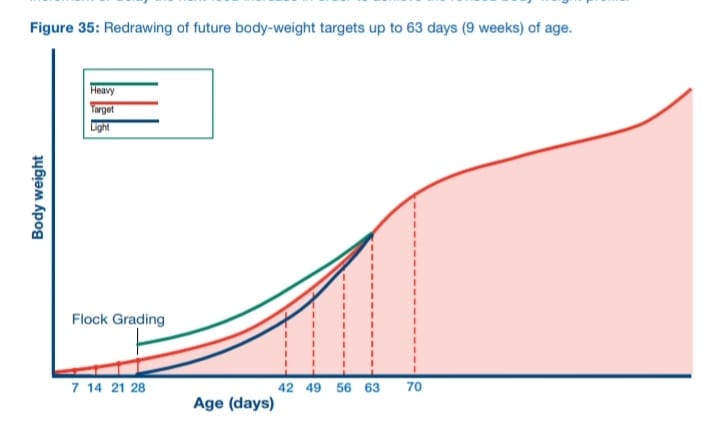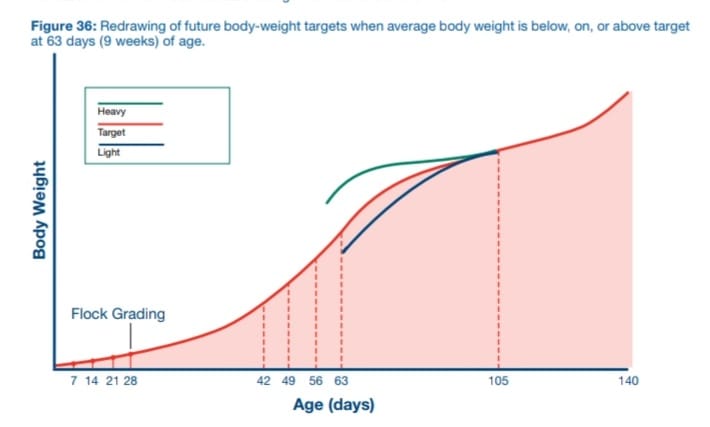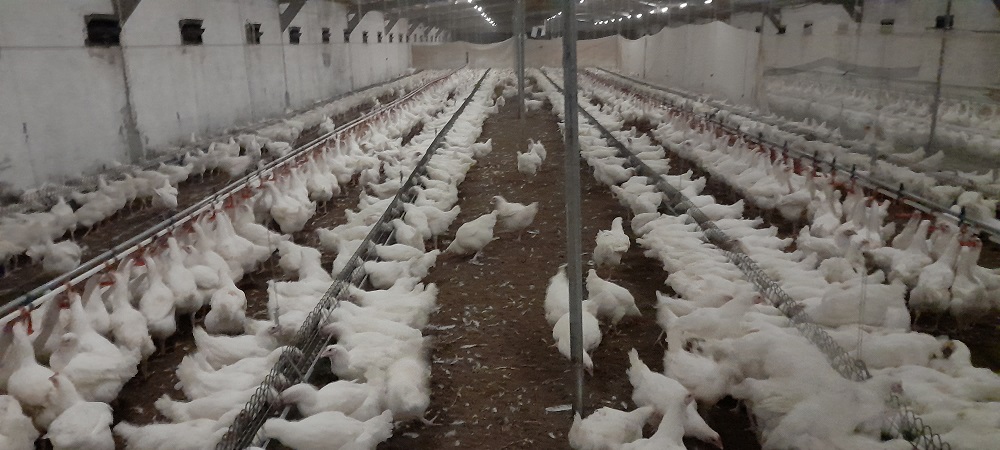BREEDER MANAGEMENT: IMPORTANCE OF UNIFORMITY AND GRADING

Picture 1: Grading & Splitting Flock till 22nd Week
Reaching the Peak Egg Production on time, sustaining Peak for 9 Weeks, Post Peak Egg production and to get highest Hatchability during Peak & maintaining optimum hatchability post peak are the critical task for any breeder farmer to optimize the operations & associated profitability. Among all the factors that can influence the breeder performance including hatchability, the most significant one is flock uniformity other than Nutrition, Health Management, Biosecurity & husbandry practice.
Grading is the process of shorting of all individual birds in a flock (both Male & Female separately) in to 3 sub-populations based on body weights (physiological state) so that each group can be managed back to the standard to have perfect uniformity in the whole flock at the point of Lay (POL). A uniform flock is easier to manage than a variable one; birds in similar physiological stale will respond more similarly to managemental factors.
Background of Grading: There is always a natural variation in a flock, even at day old. At placement, the chick body weight in a flock should have minimum variation. As chicks grow, the variation in the flock increases further due to difference of response of individual birds to factors like vaccination, disease, differing competitiveness of feed, etc. The increased variation reduces overall flock performance and makes the flock management much more difficult.
General Principles of Grading: Perform a 100% weighing & grading when the flock is 7 to 14 days old. This allows the chicks to be grouped by weight & feed intake, which controls competitions for feed from very early age. The subsequent 100% flock grading shall take place at 4, 8 & 12 weeks of age or when uniformity is below 65%. Bird’s sub-population may be classified as Heavy, Medium & Lightweight compared to the average weight.
Successful grading at progressive age helps maintaining 80% plus uniformity which is dream to any breeder farm. Countries with inefficient labour cost for multiple grading process, one compulsory Grading between 21 – 28 days age help correcting uniformity issues. Males follow the same grading concepts as female, and should have 5% more uniformity than females. Please note, males represent 10% of the flock but are responsible for 50% of the offspring
Grading is based on the variation in the body weight within a flock at the specific time. A highly variable flock with a large spread of body weights around the Average will need to be divided in more sub-populations. The average minimum uniformity in rearing phase shall be 70% (+/- 10% variation of the Mean), which need to be maintained constantly and shall be nearly 80% at POL. Uniformity below 70% at any stage indicates feed intake issue and need to be addressed being present at feeding time.
Grading Procedure: Depending on the uniformity 3 to 4 sub-populations may be made; Heavy, Medium, Light & Super light (if necessary). Some breeder houses have fixed pen or partitions and some houses has adjustable partitions; in both cases at least one pen shall be left empty during chick placement for Grading operation. It is better to have adjustable Partition and divide the whole house in 4 parts for Female & 4 parts for Male; with 2 parts each for medium size group (usually over 65% of total population), One part each for Heavy & Light Weight group for both Male & Female. Arrange Brooding in one part each for Male & female separately. Start grading on 8th day itself and shift them in different pen, keeping the lighter group at the entry side. With advancing age & body weight, arrange 100% grading at the end of 4, 8 & 12 weeks and give floor space accordingly in the respective pen. In case of fixed pen, calculate the floor space, no of feeder & drinker as per maximum no of birds to place after grading. Similarly, in case of adjustable pen adjust the size as per no of birds to be housed along with sufficient no of feeder & drinkers. If stocking density in a pen is not adjusted with floor space, feeder & drinker space, then grading will cause more problem.
Variation in a flock can be measured by 2 different ways:
1. Coefficient of Variation (CV%) – this measured the variations of body weight within the flock, the flock with lower CV’s is a less variable flock.
2. Uniformity% - this measures the evenness of body weights within a flock, the higher the uniformity the less variable the flock is.
Prior to grading a sample (3 – 5%) of birds from the flock should be weighted and the variation within the flock (as measured by CV% or Uniformity%) measured. CV% or Uniformity% may be then used for grading cut-off (the No & Av Wt of the birds to be graded in each population).

Picture 2: Grading Technique
The body weights from graded populations are should be plotted against target and the profiles redrawn where needed to bring the birds back on target at 63 days (9 weeks) age. Feed quantity shall be adjusted based on the deviation in body weight from target.
Grading using CV% From each pen2% or 50 birds, whichever is higher shall be caught randomly and taken to empty grading pen and weighted. Table 1 gives the Grading cut-off points (% of birds to be graded in each sub-populations) according the CV% of flock. Grading is not necessary when CV% is <10.
|
Flock Uniformity CV% |
% in Each Sub-Population after Grading |
|||
|
2 or 3 way Grade |
Light% |
Medium% |
Heavy% |
|
|
10 – 12 |
2 way Grading |
<=20 |
80 (78 – 82) |
0 |
|
3 way Grading |
22 – 25 |
70 (66 – 73) |
5 – 9 |
|
3 way Grading |
28 – 30 |
58 (55 – 60) |
12 - 15 |
Below is a example of 3 way Grading of adjustable pen with electronic scale:-
|
Body Weight at 4 Week |
|||
|
Total Weighted |
197 |
||
|
Av Weight |
446 |
||
|
Deviation |
0.06 |
||
|
CV% |
13.5 |
||
|
Wt (gm) |
|
Wt (gm) |
|
|
320 |
to |
339 |
4 |
|
340 |
to |
359 |
7 |
|
360 |
to |
379 |
10 |
|
380 |
to |
399 |
12 |
|
400 |
to |
419 |
14 |
|
420 |
to |
439 |
16 |
|
440 |
to |
459 |
27 |
|
460 |
to |
479 |
30 |
|
480 |
to |
499 |
28 |
|
500 |
to |
519 |
22 |
|
520 |
to |
539 |
13 |
|
540 |
to |
559 |
8 |
|
560 |
to |
579 |
6 |
|
Flock Details |
|
|
Age |
28 days |
|
Standard Body Weight (Kg) |
0.450 |
|
Actual Av Body Weight (Kg) |
0.446 |
|
Total Samle (Bird No) Size |
197 |
Considering the sample data of the flock, a 3 Way Grading is needed as below with CV%13.5:
|
Cut-off points and No of Birds in each sub-population |
||
|
|
% of Birds |
No of Birds |
|
Light Wt Birds |
24 |
47 |
|
Medium Wt Birds |
69 |
136 |
|
Heavy Wt Birds |
7 |
14 |
The light graded sub-population is aprox 24% of total population. Out of total 197 birds 24% or 47 birds are between 0.320 – 0.419 kg, means they are <= 419 Kg. Using the same process the cut-off weight of Medium & Heavy sub-populations can be determined. The Medium populations will be between 0.420 – 0.539 Kg body weight and Heavy sub-population will be >=0.530 Kg
Grading using Uniformity%
The uniformity of a flock is determind as the % of birds that are within a given range (ideally +/- 10%) around the average body weight of the flock. The higher the no of birds fall within this body weight range, the more uniform the flock and less grading is required (Table below). Grading is not required when uniformity is >=80%.
|
Grading Cut-offs when using Uniformity as Grading |
|
|
Uniformity |
No of Sub-Population |
|
65 – 80% |
2 Way Grade |
|
<=65% |
3 way Grade |
From the above 4th Weight Flock data 10% of Av Body weight = 0.450Kg x 10% = 0.045Kg. Therefore, + 10% of Av Body Wt = 0.446 + 0.045 = 0.491Kg, And -10% of Av Body Wt = 0.446 – 0.045 = 0.401 Kg. 115 Birds out of total 197 weighted are within the Average Weight range of +/-10% (0.401 – 0.491Kg), highlighted in Red colour. So. Flock Uniformity is 58% and 3 Way Grading is required. Light Wt group are those birds weight <=0.401Kg, Medium Wt group birds are >0.401Kg but <0.491 and Heavy Group are those birds >=0.491Kg
Key Issues during Grading:
- Start Grading of Male & Female simultaneously @ 2nd Week or 29th day
- A successful Grading should minimize the variability in graded flock than the original flock with the CV% shall be around 8 and Uniformity above 80%.
- Each sub-population should be re-weighted & counted to confirm the Av Body Wt and CV%/Uniformity so that projected (re-scheduled) target body weights & Feeding rates can be determined.
- Inaccurate bird counting will lead to incorrect quantity of Feed, which invite future problem
- Each sup-population should have own dedicated feeding system. Otherwise, supplementory feeding must allow even distribution of feed & adequate feeding space per bird.
- Ensure the stocking density, feeding & drinking space are consistent as per guidelines after grading; specially for the adjustable size pen.
Flock Management after Grading: Following grading, the flock need to be managed to achieve targeted body weight in graded group in uniform & coordinated manner. Post grading management to maintain uniformity within graded pen is more important than the grading itself. The most important issue is the post grading management results in the birds converging to a common target body weight at Transfer to laying house. Post Grading Feed Quantity should be adjusted to individual pen and graded birds body weights to bring each sub-population gradually back to the target line.
TAKE HOME MESSAGE
- Feed level must be recalculated on a weekly basis calculating for changes in liveability.
- Feed recalculation twice a week gives excellent results specially for Light weight group where higher increase level is required.
- Feed calculation based on individual pen birds Av Body Wt & bird numbers
- Feed level should never be reduced
- Feed level for Light Wt group should remain same first week post grading owing to the fact that reduced competition from heavier birds will give a good amount extra feed to all birds.
- Weekly Feed increase will be like:
- Smaller for Heavy Wt Bird group
- Greater for Lighter Wt Bird group
- Standard for Medium Wt bird group
- Never hold feed increment for any group for more than 2 weeks
Post Grading Body Weight management (up to 63 days/9 weeks): For each population, the aim is to achieve target body Wt uniformly during which the skeletal development takes place (by 9 Wks/63 days). After 28 days age, the body Wt of each populations needs to be monitored & feed allocations adjusted as necessary to reach the body Wt target.
Management of Under Target Light Wt Population: Where Av Body Wt of a population is more than 100gm lower than the targeted Body Wt, then the objective is to redraw the Body Wt curve so that target body Wt is achieved by 63 days. There should be no feed increase in first week after grading because reduce competition for feed will allow all birds to get more feed. Subsequent feed increase should be based on deviation from target body Wt.

Picture 3: Redrawing of Body weight Target curve up to 63 days
Management of On Target Medium Wt Population: The aim is to continue to keep birds on targeted Weight.
Management of Over Target Heavy Wt Population: Where Av Body Wt of a population is more than 100gm higher than the targeted Body Wt. the objective is to redraw the body weight curve so that birds are gradually brought back to target weight by 63 days. Feed level never be reduced but may be reduced incremental quantity and increase may be one week interval until target is achieved.
Post 63 days Redrawing of future Body Weight management: The Body weight of each sub-population should be reassessed in relation to the target. The populations with similar weight & feed consumption at this age can be combined.
Management of Under Target Light Wt Population: If some birds remain under target after 9 weeks, the body Wt target should be redrawn so that the birds can be grown to targeted body weight gradually by 105 days (15 Weeks), if not earlier. The feed quantity should be increased looking towards the new target.

Picture 4: Redrawing of future Body Wt Target curve when Uniformity is < 80% after 63 days
Management of On Target Medium Wt Population: The aim is to continue to keep birds on targeted Wt.
Management of Over Target Heavy Wt Population: If birds remain overweight after 9 weeks age, the target should be redrawn so that they can be brought back to target Body Wt gradually by 105 days (15 weeks). Feed level may be increased by giving a gap of one week and increment quantity may be lesser.
TAKE HOME MESSAGE
- Keep on monitoring weekly Body Weight compulsorily
- After 9 weeks, redraw the target Body weight Curve of any sub-population if they are below/above to targeted body weight to bring them back on target by 105 days age.
Addressing Uniformity Problem: If Av body Wt deviates from targeted body weight more/less than 100gm during rearing phase, reweight the sample flock. If similar data received, the following may be taken care:
Underweight before 105 days, consider the following in future flocks –
- May remain on Starter feed longer than suggested
- Provide a nutrient rich starter next time
- Light hours may be increased little for 3 weeks to stimulate feed intake & improve Body Wt
Underweight before 105 days, consider the following in current flock –
- Initiate the next feed increment earlier, may be mid-week and consider increasing the amount, until body weight is brought back to target.
- For example, standard increase is 5gm weekly but you want to increase 8gm, then increase 4gm at start of week and after 3 days increase again 4gm. This will help the birds to accommodate the higher increment.

Picture 5: Grading & Splitting Flock after 16 Week
Overweight before 105 days –
- Do not reduce feed level lower the current feed quantity
- Reduce next feed increase quantity, e g 2gm instead of 4gm
- Can delay next feed increment for one week
- Check the Energy (ME) level of the feed, weather higher than recommended
Any changes made to correct the body weight uniformity issue in male or female should be done gradually, ensuring positive response in body weight gain every week



